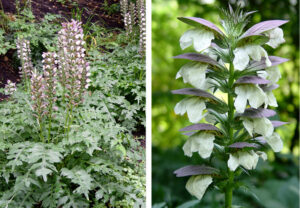Bear’s breeches
* Common name: Bear’s breeches

The habit and foliage of bear’s breeches, left, and a closeup of its flowers, right.
* Botanical name: Acanthus spinosus
* What it is: Although it’s a fairly easy and trouble-free perennial to grow, few gardeners (and almost no non-gardeners) know bear’s breeches. That unfamiliarity, combined with the plant’s eye-grabbing big flower spikes, explains why people so often ask, “What IS that?” when they see bear’s breeches in bloom.
The plant has glossy, dark-green leaves that are very spiny. In June, the plant sends hefty flower spikes up two feet above the clump that are mauve-pink and white in color and hooded in shape, somewhat like a snapdragon or maybe a turtle poking out its head. Others say there’s a resemblance to foxgloves.
No one seems to know for sure why the plant’s nickname is bear’s breeches.
* Size: The foliage clumps grow about a foot or so tall. Including the flower stalks, the total height is about three feet. Space plants about two feet apart.
* Where to use: Part shade is ideal – either in dappled light all day or morning sun with afternoon shade.
Being a Mediterranean native, bear’s breeches does well in heat and dry or gravelly/rocky/sandy soils. It holds its own under and around limbed-up shade trees. Avoid soggy spots.
* Care: Keep damp the first season, then water weekly during summer dry spells.
Scatter a balanced, organic granular fertilizer over the bed early each spring.
Cut off flower stalks after the blooms fade in August or September, but let the foliage alone through winter. Rake or clip off browned foliage in spring before new growth begins.
Shovel out any sections that are spreading beyond where you want anytime.
* Great partners: Interplant with shrubs that do well in part shade, such as deutzia, fothergilla, hydrangeas, and/or abelia. Lungwort is a good, part-shade perennial partner that blooms before bear’s breeches, while Japanese anemone is a good, part-shade perennial partner that blooms after.







